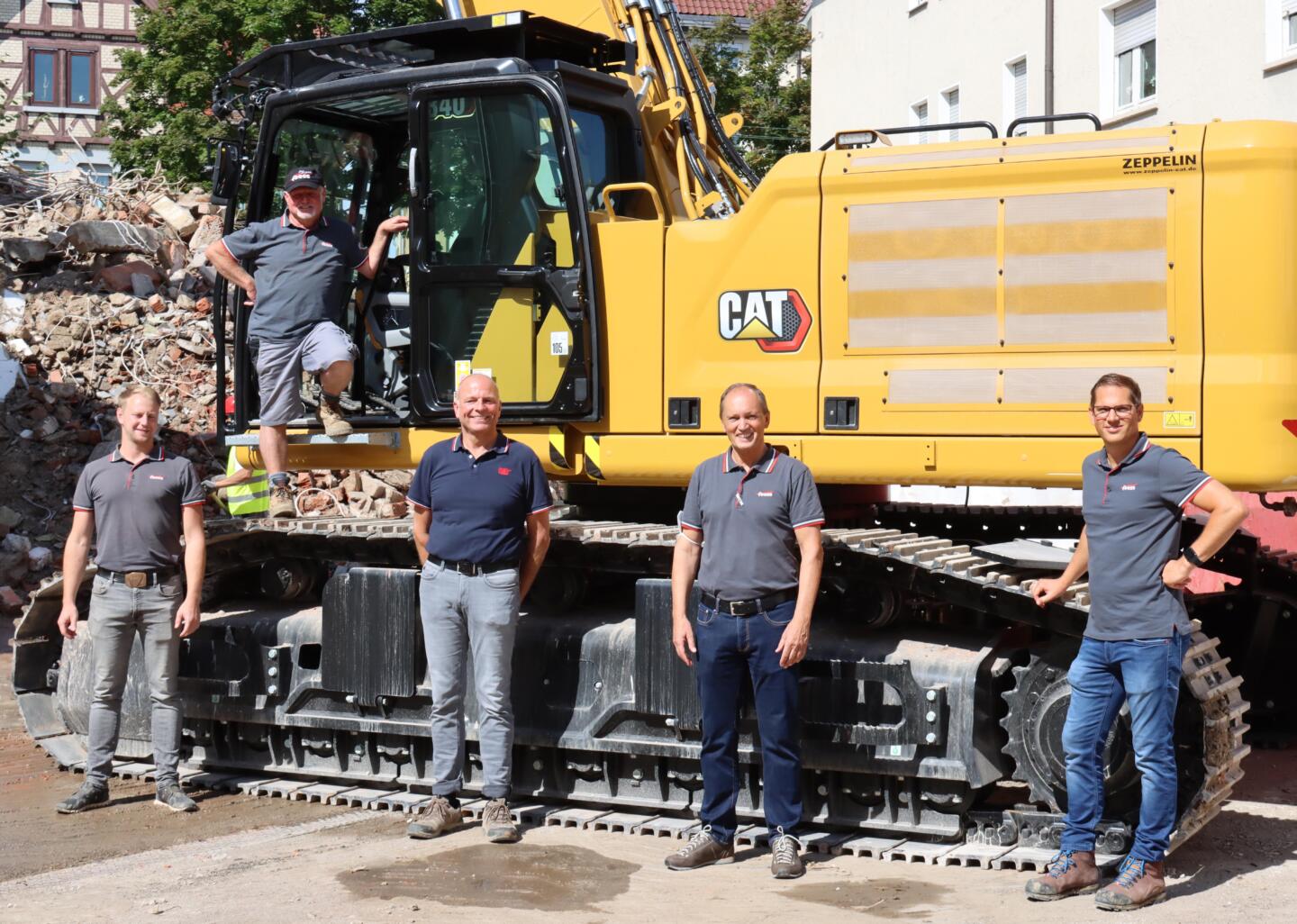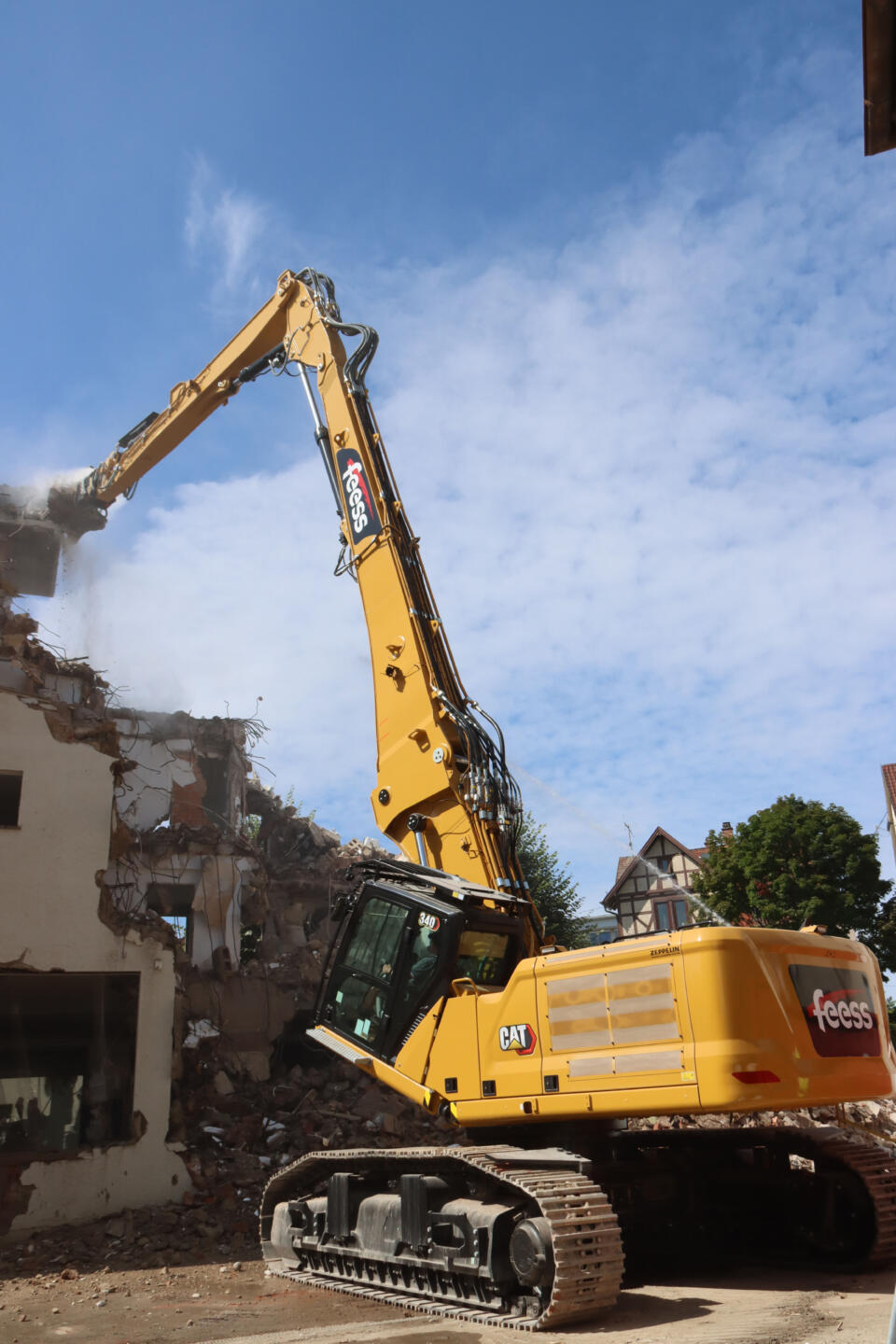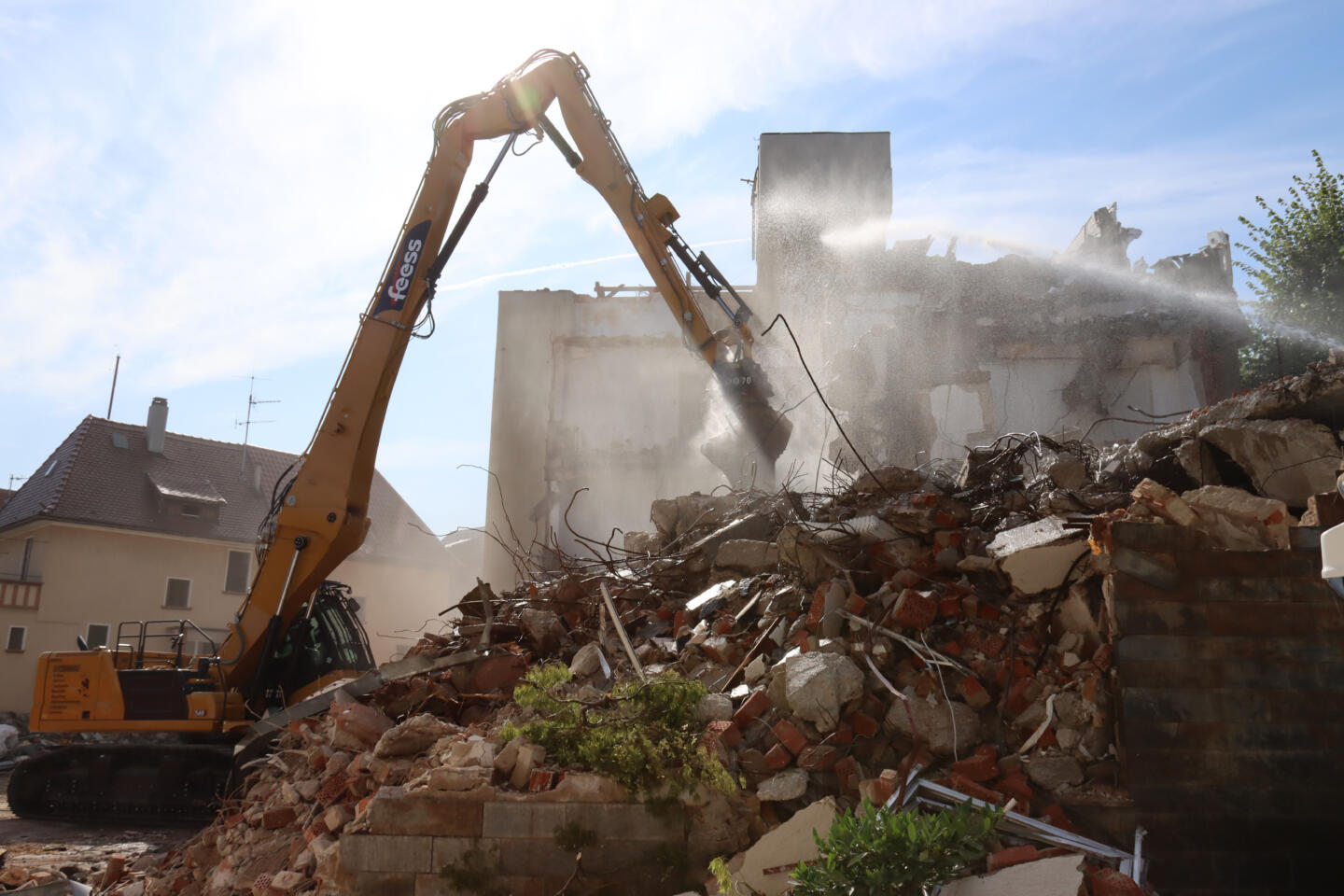Feess shows at the deconstruction of the bank branch of the Volksbank Stuttgart, how modern recycling management works.

Since the 1950s, this has been the place for banking transactions: the four-story branch of Volksbank Stuttgart in Fellbach. Its bank counters have been closed for five months – now it is being dismantled by the Feess company from Kirchheim an der Teck to create a new bank building according to modern requirements. What guides the demolition company from the disposal to the excavation of the building pit when using construction machinery: Conserve resources and recycle as reuse as many recyclable materials as possible.
The main player in the demolition is a new Cat 340 UHD crawler excavator, replacing a 330 UHD excavator. With its longfront, it achieves 13 percent more working height by allowing the new construction machine to reach 22 meters to pin height.
“The new excavator is much more stable, even when I lift, move and operate my tools weighing three tons. Every centimeter more is immediately noticeable”
says driver Siggi Beck of his new workplace.
No wonder: when extended the construction machine is four meters wide – that’s 50 centimeters more than before. Also the electro-hydraulic pilot control is now a new feature. “I have to get used to it first,” he admits. With demolition shears, sorting grabs, chisels, pulverizers and screening buckets, Siggi Beck dismantles the building and separates concrete, masonry, steel and wood. It’s less about speed and more about accuracy. Because the credo is: sort, sort, sort. And this is what the Feess employee has internalized in his 38 years of working for his employer. His boss, Walter Feess, is on fire for the circular economy and the sustainable processing of building materials, as is also practiced with the bank building.

The boss Walter Feess is convinced:
“Demolition in the city center and building in existing structures like the Volksbank in Fellbach creates space for new things and decimates the consumption of landscape outdoors. Buildings are stores of materials – concrete, sand-lime bricks and masonry bricks are all recyclable materials that need to be reused in high-quality ways, such as in building construction. This saves resources.”
He is already thinking of future generations and of his children Alexander, Benjamin and Nadine, all of whom are already involved in the company in management positions – and
This is what drives the entrepreneur to work so vehemently for the circular economy.
The consequences of climate change, such as heavy rain and heat waves, are already becoming apparent.
“We are living at the expense of the next generation. With the ruling on the Climate Protection Act in May, the Federal Constitutional Court reminded us of the intergenerational contract. This was overdue. Forward-looking recycling is becoming all the more important not only for Germany and Europe, but worldwide. Of course, companies have to earn money and a lot isa lot is already being done in recycling, but there is still more to be done”
says Feess.
In the meantime, he not only brings his mission closer as a sought-after speaker and in lectures. In addition to the recycling park in Kirchheim an der Teck, his company also operates its own competence center for recycling management. His company also operates its own Competence Center for the Circular Economy in order to teach other interested companies and their employees, architects and planners, municipal representatives and
students how modern recycling management can be implemented in the interests of greater climate protection and resource conservation can be implemented. There he and his staff also offer advice to other companies that are considering installing a building materials washing system or modernizing their existing one. Feess gives a practical
how to do it: he breathes new life into mineral waste.
Meanwhile, he now supplies twelve concrete plants with aggregate for the production of R-concrete that conserves resources.
“There is still enormous untapped potential”
says the entrepreneur convinced.
That’s why he not only started washing stones with a washing plant to free them from
clay, but in 2020 an area was acquired in Stuttgart’s Neckarhafen for the local processing of construction waste. Within a radius of two kilometers there are three customers in the form of concrete plants. This is precisely the concept that Walter Feess preaches: processing and using building materials and excavated stony or sandy soil close to the site.
“We need more processing areas. Especially the metropolitan areas are ideal because there is enough demolition material on site that can be processed and used locally. That takes the pressure off the roads. Every day, hundreds of trucks drive into and out of Stuttgart city center and out of the city center to deliver to construction sites and concrete plants – the CO2 emissions caused here could be significantly reduced. It’s high time we started saving resources”
the entrepreneur makes clear.
Up to 200 million metric tons of mineral waste are generated in Germany alone, of which 60 to 65 million tons of construction waste, most of which is landfilled. After appropriate
80 percent of this could be reused. There are ideas about what to do with it, but according to him, it is far too seldom that RCConcrete is put out to tender for building construction projects or that RC material is used as frost protection in road construction.
The entrepreneur pleads:
“Unfortunately, many architects don’t even realize that the circular economy can also be a contribution to low-cost construction. Recycled material has a negative unjustifiably a negative image. In order for a rethink to take place here, the training of architects and civil engineers, the focus must be much more on the circular
so that confidence is created.”
What also needs to be adapted, in his opinion, is the standard for the use of concrete crushing sand analogous to Switzerland – because the raw material sand in this country is
finite. If crushed sand is processed, then it can be used as aggregate for concrete production.
“Politicians must follow suit and set guidelines – our laws are no longer up to date,” is what Walter Feess tries to get across to his visitors, among them federal and state politicians from a wide range of parties, who let him show them today’s processing techniques and how modern recycling management can be implemented in practice.
He has also been rewarded for his entrepreneurial efforts and commitment: in 2016, Walter Feess was awarded the German Environmental Prize – the highest award given nationwide for environmental protection. In 2020, he received the jury prize Circular Economy of the Environmental Award for Companies in Baden- Württemberg. With this award, the state government honored exemplary companies that have aligned their operations in a particularly ecological and climate-friendly way.
For Walter Feess, this already begins on the construction sites, as the example of the demolition of the Volksbank shows. In Fellbach, the new longfront excavator nibbles down floor by floor in the middle of the city center. In order to reduce the dust load at the contact of the demolition shears with the building fabric, water nozzles with water jets and spray mist at the end of the handle and at the transition to the quick coupler. Also at the
water pressure and the necessary amount of water must also arrive at the very top.
“This is very important for demolition in the Stuttgart region”
explains Siggi Beck. After all, the dust load and associated emissions should be kept within limits.
This also applies with regard to the fuel consumption of the construction machine. The fact that the Cat 340 UHD is based on the latest EU Stage V emissions standard, there have also been some compared to the predecessor machine. Operator Siggi Beck can choose between three engine performance modes – Power, Smart and Eco – and adapts the machine to the work requirements, with the excavator then providing maximum power when needed and reduces power for less demanding tasks to save fuel. Once the demolition excavator reaches the second floor, the long front boom is replaced with the earthmoving boom to work its way down to the foundations at depths of up to three meters. The equipment change is said to take 15 minutes. “Let’s see
how fast it goes,” says the machine operator, who has yet to try it out. Then he can
also have recourse to assistance systems, such as the Payload function. It ensures that
not too much and not too little material is loaded onto trucks. This, too, is very much in the
sustainability, making full use of transport capacity and thus being as efficient as possible on the road.



 Copyright 2017-2025 All rights reserved.
Copyright 2017-2025 All rights reserved.